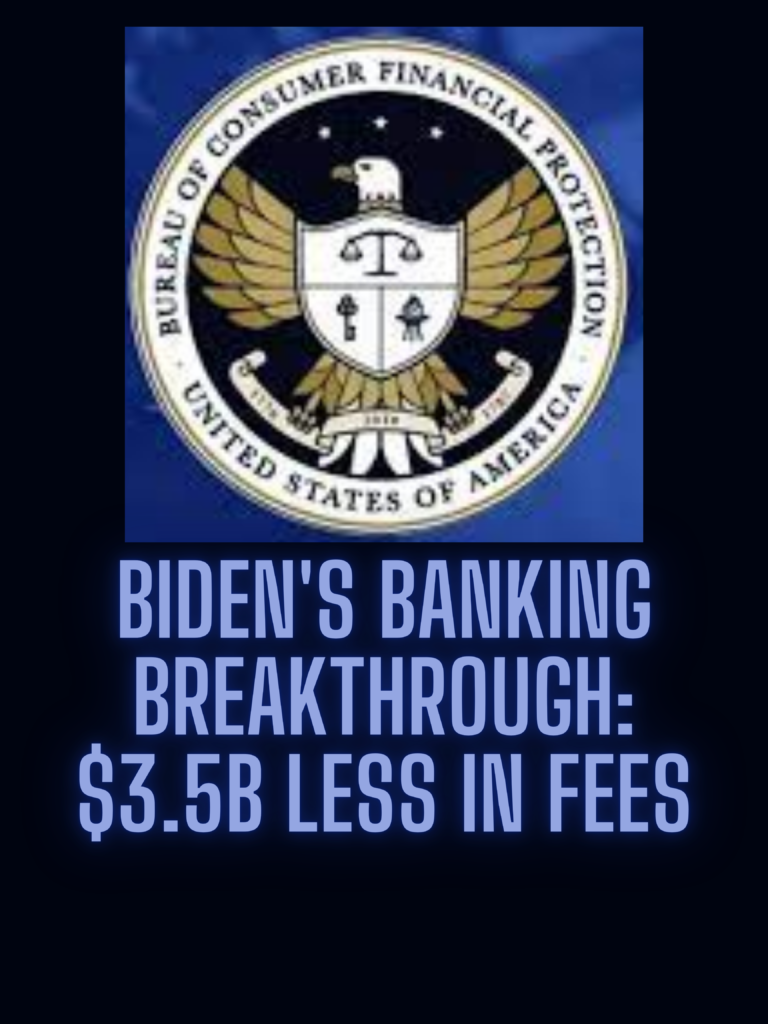Introduction:
Biden’s Banking Breakthrough: $3.5B Less in Fees. In a significant move, the Consumer Financial Protection Bureau (CFPB) has unveiled a proposal aimed at curbing excessive overdraft fees charged by major banks and credit unions. This initiative has the potential to save consumers a staggering $3.5 billion annually. Let’s delve into the key points of this groundbreaking proposal and how it could reshape the landscape of banking fees.

Biden’s Banking Breakthrough: $3.5B Less in Fees 12 Points
- 1. Closing the Overdraft Fee Loophole:
- 2. Focus on Large Banks and Credit Unions:
- 3. Potential Consumer Savings: Biden's Banking Breakthrough
- 4. Overdraft Fee Overview:
- 5. Reassessing Overdraft Practices:
- 6. Options for Financial Institutions: Biden's Banking Breakthrough
- 7. Public Comment and Implementation Timeline:
- 8. Biden Administration's Broader Plan: Biden's Banking Breakthrough
- 9. Industry Response and Potential Implications:
- 10. Legal and Cost Implications for Banks:
- Conclusion: Biden's Banking Breakthrough
- Disclaimer
1. Closing the Overdraft Fee Loophole:
The CFPB’s proposed rule targets a longstanding loophole that allowed large banks to exploit overdraft fees, turning them into a massive revenue stream. The goal is to bring transparency and fairness to a system that has disproportionately impacted those who can least afford it.
2. Focus on Large Banks and Credit Unions:
The rule specifically applies to financial institutions with assets exceeding $10 billion. And addressing the segment that serves the largest share of deposit account customers in the United States.
3. Potential Consumer Savings: Biden’s Banking Breakthrough
The proposed rule estimates that roughly 23 million households pay overdraft fees annually, and implementing this rule could save each household an average of $150 per year.
4. Overdraft Fee Overview:
An overdraft fee occurs when a bank covers a transaction despite insufficient funds in the account. The proposed rule treats overdraft coverage as a loan, subjecting it to the Truth in Lending Act to enhance transparency.
5. Reassessing Overdraft Practices:
The CFPB’s rule aims to prompt large banks and credit unions to be as forthcoming about overdraft terms as they are for other lending products, reshaping how overdraft protection is presented to consumers.
6. Options for Financial Institutions: Biden’s Banking Breakthrough
Financial institutions subject to the rule may offer overdraft protection as a line of credit tied to checking accounts, charging competitive interest rates. Alternatively, they can charge a flat fee for overdraft payments, either following a benchmark set by the CFPB or calculating a fee aligned with their costs.
7. Public Comment and Implementation Timeline:
The proposed rule is open for public comment until April 1, with potential implementation in October 2025. This extended timeline allows for thorough consideration and addresses concerns from various stakeholders.
8. Biden Administration’s Broader Plan: Biden’s Banking Breakthrough
President Joe Biden sees this proposed rule as part of a broader plan to lower costs for hardworking families, aiming to cut down on “junk fees” across various sectors, including banking services.
9. Industry Response and Potential Implications:
Banking trade groups have expressed concerns about the rule’s potential impact, emphasizing the innovations and competition that have characterized recent years. The debate centers around whether this rule could inadvertently limit access to overdraft protection.
10. Legal and Cost Implications for Banks:
Analysts speculate that the options offered to banks might be more of an illusion, with most likely defaulting to the benchmark fee set by the CFPB. Legal challenges loom, with industry representatives questioning the agency’s authority to subject overdraft services to Truth in Lending Act regulations.
Conclusion: Biden’s Banking Breakthrough
The proposed rule by the CFPB marks a significant step toward creating a fairer and more transparent banking system. If implemented, it has the potential to reshape overdraft practices and save consumers billions in fees. As the public comment period unfolds, the financial industry, policymakers, and consumers alike will closely watch the developments, anticipating the potential transformation of a system that has long been a source of contention.
Disclaimer
This article has been created on the basis of internal data, information available publicly, and other reliable sources to be believed. The article may also include information which are the personal views/opinions of the authors. The information included in this article is for general, educational, and awareness purposes only and is not a full disclosure of every material fact.
All the information on this website i.e. World Virtual CFO – is published in good faith and for general information purposes only. World Virtual CFO does not make any warranties about the completeness, reliability, and accuracy of this information. These are my views for only information purposes. Any action you take upon the information you find on this website (World Virtual CFO), is strictly at your own risk. World Virtual CFO will not be liable for any losses and/or damages in connection with using our website. For details please refer to our disclaimer page.
Dr. Dinesh Sharma is an award-winning CFO and AI strategist with over two decades of experience in financial leadership, digital transformation, and business optimization. As the founder of multiple niche platforms—including WorldVirtualCFO.com—he empowers professionals and organizations with strategic insights, system structuring, and innovative tools for sustainable growth. His blogs and e-books blend precision with vision, making complex financial and technological concepts accessible and actionable.